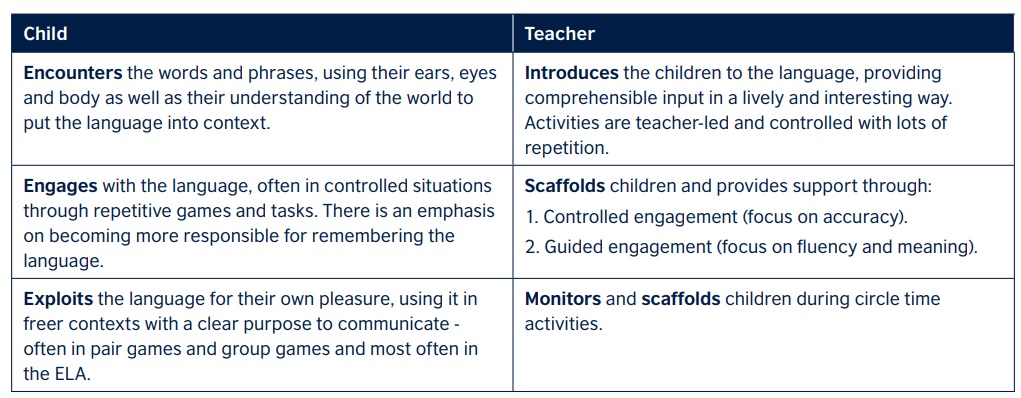Have you ever heard about EEE model? “EEE” is a model of sequencing activities for teaching children. It stands for “Encounter, Engage and Exploit” (Mourão and Gamboa, 2007).
It correlates with a well-known PPP model, “Presentation, Practice, Production”, but tends to be more friendly. Primary school is the best time to captivate children with English classes. As they are highly motivated by teacher’s personality, own ability to learn a new language. The EEE model suits language centres, anyway, some elements can be tailored to public schools. Learning with this model is easy and natural for kids.
Stages of the EEE model
Encounter
It’s a teacher-led step. The teacher models and scaffolds the language, listening comes before speaking. This stage activities stimulate a group physical response in chorus. Make sure your tasks involve all children as they will feel safe and be more confident in a group.
Engage
This step is teacher-led as well. It is usually a controlled practice through games to improve students’ accuracy, fluency and understanding of tasks. In the beginning children give choral responses. However, kids can slowly respond individually in the group. Learners mime or whisper the words, or say them with “mouth” but voiceless, say separate syllables. At this stage, they are still listening more, remember the language and becoming more confident with it. Do not insist and push students, let each child answer at their own pace. In addition, you can firstly ask for a physical response and then slowly move to oral responses. Also, use a puppet and praise children to grow confidence in them.
Exploit
The third stage is more student-centred and includes tasks that have a real communicative purpose and encourages young learners to be creative. It gives kids an opportunity to choose the language they want to use and practise it individually. It provides students with opportunities to give individual oral responses. Don’t forget to create a supportive environment, use puppets to encourage children. Help kids exploit English for real purposes, e.g. leading a routine, leading a game.
However, there’s a slight difference between 2 approaches: PPP is teacher-led whereas EEE is child-centred, it provides both teacher and students with opportunities to choose and order the activities. See Table 1 from “English learning areas in pre-primary classrooms: an investigation of their effectiveness” by Penelope Robinson, Sandie Mourão and Nam Joon Kang

As you can see in the third stage children can choose and use the language in a freer setting. Therefore, teachers consider what learners need the guidance of their communication in English.
Examples of games for each stage:
- Encounter:
- “Listen and do” (teacher model gestures for each word; then, the teacher says a word and children repeat and mime it).
- “Freeze” (repeat the game above, but when the teacher says, “Freeze”, kids stop. The one who moves is out of play.
- Engage:
- “Find pairs”. Have students turn 2 flashcards and say what they see. If they’re the same, they get a point. If they’re not, they turn them back and open the next ones to find pairs.
- “What’s missing”. Put some flashcards for the student to remember. Tell children to close their eyes and take one card away. Have them remember which one is removed.
- Exploit:
- Board games. Make it using pictures from the lesson. Have children roll the dice, move and name a picture. If they can’t, they go back.
- Bingo. Make cards with 6 pictures on them. Call out words in random and have students cross. The first to cross a line is the winner. Another option is to play a song with target words and ask student cross pictures when they hear a word.
For more ideas and games, check here, page 34 and here.






 Маргарита Аветисян
Маргарита Аветисян 
 Вероника Аветисян
Вероника Аветисян 


